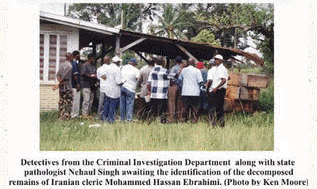-was
shot twice in the head
Thursday, May 6th 2004

Police spokesman John Sauers yesterday said police
discovered Ebrahimi's
body on Tuesday evening in a shallow
grave four hundred yards off the St. Cuthbert's trail
and about three and a half miles from the Linden-Soesdyke
Highway.

According to Sauers, the partly decomposed body was
positioned face down in the three feet deep grave. His
mouth was covered with duct tape which was also used
to bind his feet as well as his hands, which were
behind his back. The body was also outfitted in the
same clothes Ebrahimi was wearing when he was last
seen alive.

There were two gunshot wounds to the head, which
was decomposed to such an extent that the skull was
clearly visible along with the entry and exit wounds
of the bullets.
It is believed that one of the bullets entered the
right side of his face and exited through the top of
his skull, while the other was fired at the left side
and exited through one of his eyes.
"I will take the liberty to represent that
that is the body of Hassan Ebrahimi," Abdul
Kadir told reporters after he and a close
family friend identified the body at the Le Repentir
Mortuary yesterday morning.
Because of the advanced stage of decomposition his
body was stored at the mortuary, where the
identification was done.
Kadir confirmed the description of the body that
was detailed by the police and based on what he had
observed he estimated that it may have been buried for
about two or three weeks, though he did admit his was
a technically uninformed opinion. This opinion would
also suggest that the cleric was
alive for around a week following his kidnapping.
Kadir noted that police still have to determine a
motive, though he said he imagines they did their
best.
"The police's ability to solve crimes is
dependent on the resources at their disposal and
willingness to solve crimes... in the Guyana context,
I would like to think that the police did their
best," he said before he was joined by the uncle
of Ebrahimi's pregnant wife, who is due to deliver any
day now. Several appeals by relatives of the man were
made in the local press for his release.
Iranian
Foreign Minister Kamal Kharrazi recently voiced
concern over the kidnapping and had called on
officials here to work quickly to secure his release.
"We want the necessary action to be taken to
release him as soon as possible and for the abductors
to be prosecuted," the minister was quoted as
saying by IRNA news agency. Following this statement,
the Iranian Ambassador to Venezuela and several
investigators travelled to Georgetown and had meetings
with the Minister of Foreign Affairs Rudy Insanally
and other officials.
Kadir said it is possible that Guyana could soon be
revisited by Iranian police.
On the night of the
kidnapping, Ebrahimi had been asked by an official of
the college to return there because of a water leak.
This appeared to be a ruse to get him to return to the
facility as no water leak was ever found. In the
professionally-executed kidnapping, the vehicle
Ebrahimi was to travel in was disabled by gunfire and
another official travelling with him was shot in the
foot.
The police - including elements of a new
anti-kidnapping unit - could find no trace of the
cleric and the absence of a ransom demand has led to
widespread speculation about the reasons for the
abduction. Questions have also been raised over why
Guyana was chosen for the site of the college.
During the police investigations, a local muslim
school was controversially raided but no sign of the
cleric was found.
Meanwhile, the interim head of the college Sheikh
Salim Ibn Abdul Kadir would not pronounce on the
future of the institution, which issue he says does
not take precedence at this time


